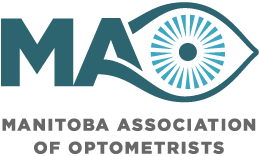
At birth, babies can see blurred patterns of light and dark. During the first four months of life, vision becomes clearer, colour vision begins to develop, and the two eyes start working together. By the time a baby is six months old, they will have acquired eye movement control, and have developed eye-hand coordination skills. Discovering different shapes and textures with their fingers and playing “patty cake” and “peek-a-boo” will all help a baby’s visual skills develop.
6 Months Old - First Visit to the Optometrist
The Canadian Association of Optometrists recommends that babies have their first eye examination between six and nine months of age. This is an important time to ensure eyes are healthy, eye and muscle movements and alignment are developing properly, and the eyes are focusing together. An accurate and complete eye exam can be performed without the need to read the eye chart; an optometrist will test for nearsightedness, farsightedness, astigmatism, eye movement, and eye health.
There are a few ways to make this first visit more enjoyable:
- Work around fussy times.
- Schedule the appointment at a time when baby is generally relaxed and happy
- Ask to have any required paperwork sent to you before the appointment so that it can be completed at home and brought to the appointment.
A number of serious eye conditions exist that can be identified during the first eye exam. If left uncorrected, these conditions can result in serious vision problems. However, with early detection and treatment, many vision problems are reversible and in some cases preventable.
6 to 12 Months Old
At this stage babies are quite mobile and are developing the vision skills necessary to use both eyes together, to judge distances and manipulate their surroundings with greater accuracy. To encourage the development of eye-hand-foot-body coordination, try not to encourage early walking; crawling and exploring are important right now. Offer toys that baby can touch, hold, and see at the same time.
First Birthday to Third Birthday
During this stage eye-hand coordination and depth perception will continue to develop. Learning to see efficiently and effectively requires full coordination between the two eyes. Active playing and normal toddler games all help develop and strengthen a child's vision. By the age of three, many of the vision skills required for life-long learning are reasonably developed.
3 Years Old - Second Visit to the Optometrist
By age 3, an optometrist should reassess a child's visual system to confirm the absence of any eye disease, as well as monitor the continued growth and efficiency of visual skill development. This is also the examination where eye muscle problems such as crossed-eyes (strabismus) and lazy eye (amblyopia) are carefully assessed.
Amblyopia, or lazy eye, is the loss or lack of development of vision in an eye that is healthy. Amblyopia can be caused by crossed-eyes (strabismus), unequal refractive error, farsightedness or nearsightedness, or a physical obstruction like a cataract. The brain "learns" to see with the good eye only, and the other eye grows weaker from disuse. It is estimated that 2 - 4% of all children have amblyopia. Amblyopia is responsible for more cases of vision loss in children than all other ocular diseases and traumas combined. If detected and treated at an early age, amblyopia will often resolve completely.
Third Birthday to Fifth Birthday
Through these important years, a child's eyes will gain all the necessary vision skills to be ready for reading and learning at school!
Possible Signs of Vision Problems
Be alert for symptoms that could indicate a child has a visual problem, including:
- Red, itchy or watering eyes
- Sensitivity to light
- An eye that turns in or out
- Squinting, rubbing the eyes, or excessive blinking
- A lack of concentration
- Covering or closing one eye
- Holding objects very close to the face
- Avoiding books and television
- Visible frustration or grimacing
- Tilting the head or unusual posture
Vision and Success at School - Third Visit to the Optometrist
A child’s third visit to the optometrist should take place before their first day of school. This is an important opportunity for the optometrist to assess well vision is continuing to develop and ensure that a child’s eyes are ready to support learning as they begin school.
Continue reading about school-aged vision
Search for an optometrist in your area with Find an Optometrist
